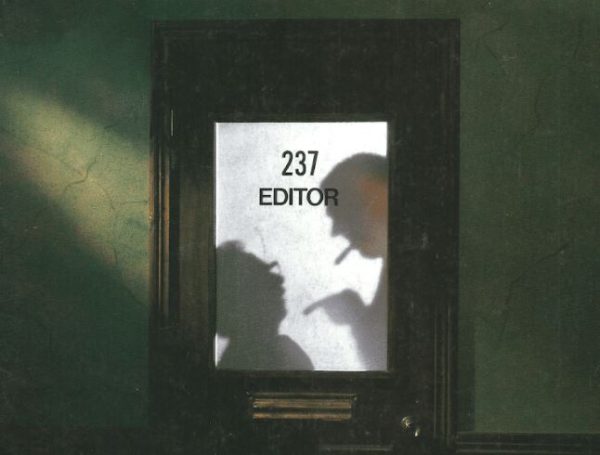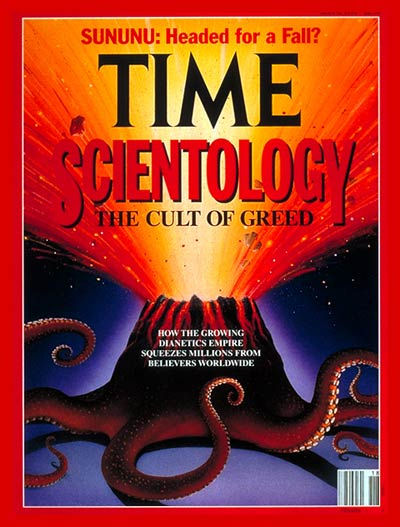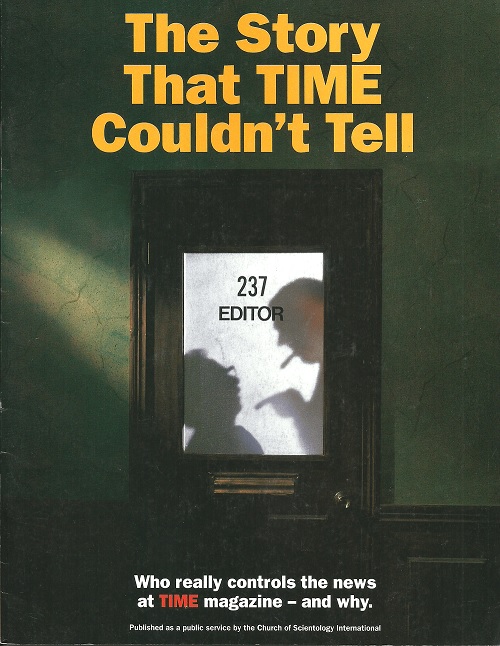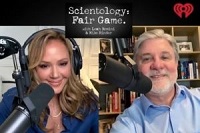
(A note from Chris: Many thanks to the benefactors whose generosity has been essential in covering the cost of the research subscriptions that enabled me to write this article (and much more besides). If readers would like to help contribute towards further research, please see my Patreon page. Thank you for your continued support!)
Scientology’s public image has taken a beating in recent years with revelations of abuse at every level of the organization. It’s not the first time, however, that it’s had to deal with a shattered image. Thirty years ago this month in May 1991, its efforts to rebuild its reputation were derailed by the publication of Richard Behar’s classic exposé of Scientology, “The Thriving Cult of Greed and Power”.
By the mid-1980s, the church’s image was in ruins due to the exposure of the Guardian’s Office in 1977, and the subsequent jailing of 11 top Scientology officials — including L. Ron Hubbard’s wife. It suffered further damage from the years of internal turmoil that accompanied the rise of David Miscavige.
The church had relied for decades on Hubbard’s own ‘PR tech,’ which he claimed was superior to any ‘wog’ alternatives. The disastrous coverage that had accompanied the trials of the indicted GO officials led Hubbard to admit privately that ’wog’ assistance was needed after all. He secretly advised the new leadership around Miscavige that a small and “hungry” PR company should be brought in to assist Scientology.
A Santa Monica man named Bill Widder, who owned a company called Dateline Communications, was hired by Miscavige’s Author Services, Inc. (ASI). He worked to promote Hubbard’s Battlefield Earth and other Scientology properties. However, his small-scale work does not seem to have had much impact, and Widder later ended up on a list of “Suppressive Persons.”
After Hubbard’s death, Miscavige decided to approach a ‘wog’ public relations firm on the advice of Gerald Feffer, one of the church’s leading lawyers. In late 1987, Scientology hired Hill & Knowlton (H&K), a famous Washington, D.C.-based firm that was part of the giant British-owned media group WPP — now the world’s largest advertising company.
H&K was not a large company but it was extremely well-connected politically. Scientology had long sought to lobby the US government to advance its interests, particularly in its ongoing battle for tax exemption, which had become increasingly urgent due to the need to dispose of Hubbard’s estate. H&K’s connections with the then-governing Republican Party gave it considerable political clout in addition to its PR expertise.
H&K agreed to help Scientology to “neutralize negative media coverage; … [build] a new and positive public platform for the Church; and promote the many positive aspects of Scientology,” along with contributing to recruitment activities and retention of the church’s existing members.
The firm believed that it well understood the difficulties of working with Scientology. It had a long reputation of dealing with what it called “highly controversial clients,” such as dictators and authoritarian governments, that it helped to burnish their reputations overseas. “Principled clients conducting honest operations toward laudable and legitimate ends,” H&K wrote, “come to us when they are much misunderstood and maligned in the marketplace.”
The company was nonetheless very cautious about engaging with Scientology. “It’s potentially a very dangerous account,” one senior executive warned. Its chairman, Bob Gray, reportedly hit upon a remarkable solution: While agreeing to represent Scientology on a provisional basis, H&K would secretly investigate the church with its own private investigators, infiltrate it and satisfy itself that Scientology was no longer engaged in illegal activities.

Gray’s own background as a former CIA officer may have inspired him to take such an unconventional intelligence-based approach. The results evidently gave him the confidence to go ahead with agreeing a contract with the Church of Scientology International (CSI). H&K nonetheless approached it cautiously. CSI agreed to pay a $90,000 “controversy premium” to secure the firm’s services, as a way of compensating it in advance for any loss of business that might result from taking on Scientology as a client. It paid H&K up to $100,000 a month to provide a range of PR services. The relationship initially appeared to pay off for both sides: Scientology became H&K’s third biggest client.
Under H&K’s tutelage, Scientology aimed to reposition itself as a friendly, socially conscious organization focused on education, the environment, and social well-being. Its in-house advertising became much slicker and more professional, in contrast to the somewhat amateurish output of previous years. The church took out high-profile advertisements in newspapers, magazines and on television, and sponsored public events where its brand shared the limelight with corporate leaders such as Sony and Pepsi.
Behind the scenes, however, tensions were emerging between Scientology and H&K. The reason, as usual, was the Scientology leadership’s fanatical adherence to Hubbard’s policies. Scientology still suffered from bad media coverage, which it sought to neutralize not only through PR but through its well-established playbook of using private investigators to intimidate and ‘expose’ reporters. Gray objected to this approach, advising Scientology to be more patient and conciliatory. “They would attract more flies with honey,” as one of Gray’s executives put it.
This, however, was literally anathema to Scientology. Although the church gave H&K a supposedly “full library” of Scientology materials to inform its approach to PR, it almost certainly did not share Hubbard’s numerous secret instructions on how to deal with critics and other ‘enemies’ of Scientology.
H&K also almost certainly did not fully appreciate the depth of Scientology’s adherence to conspiracy theories about psychiatry. This was particularly problematic as one of H&K’s sister companies represented Eli Lilly, one of the world’s largest producers of psychiatric medications, including the recently-launched ‘wonder drug’ Prozac.
Not long after Prozac was launched, Scientology’s anti-psychiatry front group, the Citizens’ Commission on Human Rights, started a campaign against “psychiatric drugging” that focused on the drugs Ritalin and Prozac in particular. It was a local initiative that attracted little attention from the media — or support from Scientology’s leadership — until a mass shooting in September 1989. A Kentucky printing operator suffering from manic depression shot 20 of his fellow employees, killing eight of them. Subsequent analysis of his blood disclosed that he had been taking Prozac and other psychiatric medications.
In the media frenzy that followed, CCHR’s spokespeople acquired a high media profile by repeating a simple but false explanation for the massacre: Prozac had driven the shooter to commit mass murder. A CCHR representative testified at the inquest and convinced the coroner to endorse its claim that the drug might have been a contributing factor. Although medical experts discounted this, victims and grieving relatives soon began to file lawsuits against Eli Lilly, further fueling the controversy. (Lilly later settled the lawsuits out of court.)
The tragedy offered Scientology an unprecedented opportunity to achieve long-sought public acceptance as a leading campaigner on mental health. Decades earlier, Hubbard had ordered that Scientology was to take a lead in “cleaning up” and ultimately taking over the field of mental health care. According to Marty Rathbun, then the Inspector General of Scientology’s Religious Technology Center (RTC), Miscavige ordered that CCHR was to “mobilize on Eli Lilly and Prozac.” RTC officials coordinated with counterparts from the Office of Special Affairs (OSA) and CCHR to work up a “full scale attack.”
Over the following two years, CCHR and Scientology mounted a ferocious attack on Eli Lilly and Prozac, spending millions of dollars on anti-Prozac advertisements and disseminating lurid anti-psychiatric propaganda. Doctors reported patients stopping their Prozac treatments, potentially endangering their health. Scientology unsuccessfully petitioned the US government to withdraw the drug’s license, which would have had a devastating effect on Lilly’s profits had it succeeded.
The company tried initially to ignore the campaign but found its share price and sales dropping alarmingly as a result of the attacks. Alarmed and angered, Lilly executives condemned Scientology’s actions: “Take the nastiest negative campaign in politics you have ever seen and cube it,” Lilly executive — and later governor of Indiana — Mitch Daniels commented.
Even as CCHR was hammering Eli Lilly, OSA learned in late 1990 that Richard Behar, a journalist for Time magazine, was researching a major story on Scientology. Four years earlier, Behar had written a scathing piece for Forbes magazine exposing Scientology’s business dealings and L. Ron Hubbard’s wealth. He subsequently compiled a file of tips and news cuttings that grew steadily as people around the world had reached out to him. By 1990, the file had grown to such proportions that Behar decided it was time for a more in-depth article on Scientology.

The Scientology leadership had good reason to be worried when OSA learned of the planned article. Behar was a formidable investigative reporter with extensive contacts among ex-Scientologists. His publication, Time, was one of America’s most prestigious media properties and had a worldwide audience. A blockbuster story on Scientology would likely have a bigger impact than a similar effort from almost any other US outlet. It also came at a delicate moment for Scientology’s long-running battle with the IRS. With a billion-dollar tax bill hanging over it, a Time magazine exposé was the last thing that the church needed.
Scientology’s response to Behar’s previous article had been relatively muted, with a token number of legal threats and nudges from private investigators. This time, the church did not hold back. Ten church attorneys and six PIs were assigned to “threaten, harass and discredit” Behar, as he put it. Scientology refused his requests for interviews, claiming that it would like “sending out Saddam Hussein to do an interview on Jews.”
Despite the efforts of Scientology’s investigators, it was nonetheless taken by surprise at the extraordinarily damaging nature of the article when it was published on May 6, 1991. Behar had pulled no punches. “The Thriving Cult of Greed and Power” depicted Scientology as “a hugely profitable global racket that survives by intimidating members and critics in a Mafia-like manner.”
Its publication – and its later worldwide reissue in condensed form by Reader’s Digest – caused an immediate crisis for Scientology, due to its huge reach, around 6 million readers in Time and a further 100 million in the Reader’s Digest. It attracted a massive response from readers and prompted around 1,200 letters to Time’s editor – a record for the magazine.
The story’s publication was fortuitous for Eli Lilly. The company seized the opportunity to print a reported 250,000 copies of Behar’s story and distributed them to doctors throughout the US, aiming to inoculate them against Scientology’s anti-Prozac claims. A nearly simultaneous article in the Wall Street Journal also highlighted Scientology’s role in the campaign; Lilly reportedly reprinted 750,000 copies of the article for redistribution. The media coverage certainly had an effect. Doctors and patients took note of it and began prescribing and requesting the drug again. As the Harvard physician Joseph Glenmullen puts it, “the link between the Church of Scientology and the scare greatly reduced its credibility”.
The article also prompted the collapse of Scientology’s relationship with H&K. Miscavige’s decision to launch a war against Lilly had put its PR advisors in a very difficult position. Lilly’s PR was being handled by one subsidiary of the WPP marketing group while another WPP subsidiary, H&K, was working with Scientology, though not participating directly in the attack on Prozac. In effect, one WPP client was using PR to attack another WPP client. Such a clear conflict of interest could not be sustained.
Well before the Time article was published, Lilly put pressure on WPP to terminate H&K’s contract with Scientology. The pharmaceutical giant was a far bigger client than the church, and the potential loss of the Lilly contract would cause much more financial pain than terminating that of Scientology.
To add to the risks, H&K’s relationship with Scientology hurt other parts of its business and jeopardized its relationship with European pharma companies. The British firm SmithKline Beecham (SKB) signed a $1.5 million contract with H&K just before Behar’s Time article publicized the PR firm’s link with Scientology. SKB summarily terminated the contract on learning about the Scientology connection. It had not previously known about the link and was angered by H&K’s failure to disclose it.
The 48 hours following the Time article’s publication saw senior OSA official Kurt Weiland frantically making conference calls with H&K to work out how to respond. H&K’s Bob Gray initially sought to dissuade Scientology from taking its usual scorched-earth approach, pitching the idea of a running a response in Time’s rival Newsweek.
However, the relationship between Scientology and H&K was no longer sustainable. The potential damage was severe: H&K had already lost SKB and Lilly let it be known that it would cancel its own contract with H&K if the latter continued to keep Scientology on as a client.
The news galvanized the group’s head, Martin Sorrell, to order H&K to end its relationship with Scientology. Five days after the publication of Behar’s article, Gray called Miscavige to tell him that he was terminating the Scientology contract. H&K chief executive Robert Dilenschneider said publicly that the firm had not known about the upcoming Time article, had “never felt comfortable” about representing Scientology and “felt uneasy about some of their methods.”
The decision was met with fury among the Scientology leadership, which saw it as a betrayal. The intemperate and vengeful Scientology campaign that followed drew on the familiar playbook of the “noisy investigation.” Convinced that there was a conspiracy between Lilly, Time and WPP, the church used private investigators to personally target Lilly executives. Some executives received harassing phone calls at home and hoax calls at work, while advocates of psychiatric pharmaceuticals also reported sustained harassment. Jeffrey M. Jonas, the author of a book about Prozac, received at least six bogus calls a day for several weeks, while a mental health group received calls from people posing as reporters.
Two private investigators hired by the church, Paul Marrick and Greg Arnold, systematically spied on Mitch Daniels in a futile effort to find dirt on him. They staked out his home in Indianapolis, surveilled his domestic activities and monitored his visitors. “We saw him watching TV through his front window,” Arnold later said. “We watched his … daughters. They were young then. It was everyday living. Nothing came of the investigation.”
Time bore the brunt of the church’s assault. Scientology sued the magazine’s publisher, Time Warner, and Behar personally for $416 million in libel damages. It also sued Reader’s Digest in multiple countries, filing at least 20 lawsuits. At the same time, it launched a multi-million dollar advertising blitz, running an expensive series of full-page color adverts in USA Today to denounce Time. It also invested heavily in private investigators to target those involved with the article. In all, Scientology reportedly spent $25 million (about $48 million at 2020 prices) on its campaign against Time and Behar.

A church press release claimed darkly that “vested interests” – Scientology’s usual term for psychiatrists – “used their power to force Time to print their article on Scientology.” The church promoted a conspiracy theory that Lilly had instigated the Time article. As Miscavige put it in an interview a year later, “It was done at the behest of Eli Lilly. They were upset because of the damage we had caused to their killer drug Prozac. They set up that article. They used their advertising dollar to force it to run, and that’s the facts.”
Scientology produced 2.2 million copies of a 28-page publication called “The Story Time Couldn’t Tell,” which was inserted into Friday editions of USA Today. The church accused Time of being a “four-bit news magazine wield[ing] unabashed Nazi-style hate propaganda” and claimed to expose the “mafia-like tactics” of the “cabal behind this vitriolic attack.” It portrayed Time as having a history of supporting fascism, of being under the thumb of Eli Lilly and of being a puppet of psychiatry.
Rather than boosting Scientology’s case, however, the church’s denunciations came across as unhinged and only served to support Behar’s narrative. As H&K’s Robert Dilenschneider noted, it was bad PR tactics. “You make your case and step away,” he said. “Otherwise you run the risk of possibly reinforcing the initial negative image.”
Behar was closely surveilled by private investigators, prompting Time to hire its own PIs to tail Scientology’s. The Scientology PIs sought to obtain information about his health and finances from acquaintances and family members, and also posed as people trying to get friends or relatives out of Scientology in an apparent effort to link him to anti-cult groups. According to Marty Rathbun, an apartment was hired on Behar’s block to serve as a centre for the operations against him. His personal credit record was acquired under a pretext by a “sham company” linked to Scientology.
When Behar was given the prestigious Gerald Loeb Award for his work on the article, extra security had to be hired for the award ceremony to prevent it being disrupted by Scientologists or their PIs. Earle Cooley, the church’s lead attorney, justified the surveillance on the grounds that Behar “consistently has manifested hatred toward the church…. If you do not investigate a person who’s doing that to you, you’re derelict in your own duty”.
The church’s lawsuit against Time ultimately failed after ten years of litigation, but not before incurring at least $7 million in legal fees for the magazine (though much of Time Warner’s costs were covered by insurance). A parallel $40 million lawsuit against H&K and Eli Lilly was eventually settled in 1994. According to church insiders, Scientology was given a few million dollars as compensation for the termination of the H&K contract. In return, it agreed to cease attacking Eli Lilly and Prozac.
Scientology’s campaign had aimed to get Prozac removed from the marketplace, but it failed utterly. In 2001, Eli Lilly’s patent expired on the Prozac drug – fluoxetine hydrochloride – which now began to be made by generic pharmaceutical producers. Ironically, though, some of CCHR’s concerns have since been verified by medical researchers and fluoxetine is now subject to additional regulations and warnings over its usage.
In the meantime, Scientology has not only failed to end “psychiatric drugging” but has shrunk to a fraction of its 1991 size. For all the noise and controversy, its anti-Prozac campaign turned out to be little more than a bump in the road: the drug has become the most widely prescribed antidepressant in the world, despite all of Scientology’s efforts.
— Chris Owen
——————–
Bonus items from our tipsters
Chicago is ramping up!

“I found out that it makes it tremendously easier to run the bank and that on a very few PCs you will be unable to run the bank unless you get an early engramic incident out of the road. And I also found out that if you can run the overt engram that relates to these GPMs just as an engram, that a fantastic amount of charge will come off the implants themselves, naturally, and therefore they run very much like hot butter. I had a little bulletin for you. Found a datum here you might be interested in. That particular outfit was down toward the center of this particular galaxy and was founded at 52 trillion, 863 billion, 10 million, 654 thousand, 79 years (52,863,010,654,079), and I can’t give you a much closer than that, because when place get founded is, more or less becomes part of their lies. But it was founded at that time, and it was destroyed on the date 38 trillion, 932 billion, 690 million, 862 thousand, 933 years ago (38,932,690,862,933), by the 79th wing of the 43rd battle squadron of the galactic fleet. It was not the, part of the galaxy. It was a wildcat activity sitting there. They used to drag Magellanic Clouds out of the center hub of the galaxy, let them follow the lines of force and just let them come over a system. Then when they got around to it, they’d send planes in with speakers, and so forth, and give the place the business. But the place very often was totally caved in for thousands of years by these Magellanic radioactive clouds which would just engulf the particular system. You got the idea? I just give you that in brief, just as a matter of interest, because these dates we’re getting are accurate. I have now compared them up the track and squared them around. These are the dates.” — L. Ron Hubbard, May 16, 1963
——————–
“Logic (The Data Series) is written up to Data – 4 now. Occurred to me what if CIA’s multi-billion facts in computers were properly analyzed, WOW, what a different answer they’d get! I realized that as it is ‘analyzed’ they can only decide to go to war with everybody! And do. I can see a conference now at ‘high level.’ ‘What’s the situation on Hamfatia?’ ‘Threatening.’ ‘What’s the situation on Sphagettiville?’ ‘Threatening.’ ‘What’s the situation on the world?’ ‘Threatening.’ ‘Then it’s all threatening?’ ‘Yes.’ ‘Good hit the war button!’ They didn’t notice the ‘Threatening’ button had gotten leaned on by the cleaning lady’s mop the night before. And that’s the way the world went. Point is, if one can’t analyze data he winds up hating everybody — as it’s just one big generality. We’re into real 3rd dynamic tech!” — The Commodore, May 16, 1970
——————–
“The R2-45 process is valid (as far as I understand) in the Sea Org. Governments have not forbidden it, why? Because life has the right to kill its enemies. Governments do that all the time. The peace you enjoy in society is due in part thanks to the people in governments who kill subversives, silently and without sorrow.”
——————–
2000: Battlefield Earth was released in the U.S. this week. From Roger Ebert of the Chicago Sun-Times: “‘Battlefield Earth’ is like taking a bus trip with someone who has needed a bath for a long time. It’s not merely bad; it’s unpleasant in a hostile way. The visuals are grubby and drab. The characters are unkempt and have rotten teeth. Breathing tubes hang from their noses like ropes of snot. The soundtrack sounds like the boom mike is being slammed against the inside of a 55-gallon drum. This movie is awful in so many different ways. Even the opening titles are cheesy. The director, Roger Christian, has learned from better films that directors sometimes tilt their cameras, but he has not learned why. I watched it in mounting gloom, realizing I was witnessing something historic, a film that for decades to come will be the punch line of jokes about bad movies. There is a moment here when the Psychlos’ entire planet (home office and all) is blown to smithereens, without the slightest impact on any member of the audience (or, for that matter, the cast). If the film had been destroyed in a similar cataclysm, there might have been a standing ovation.”
——————–
“I’m on drugs.”
——————–
Full Court Press: What we’re watching at the Underground Bunker
Criminal prosecutions:
— Danny Masterson charged for raping three women: Preliminary hearing set for May 18.
— Jay and Jeff Spina, Medicare fraud: Jay sentenced to 9 years in prison. Jeff’s sentencing to be scheduled.
— Hanan and Rizza Islam and other family members, Medi-Cal fraud: Pretrial conference May 20 in Los Angeles
— David Gentile, GPB Capital, fraud: Next pretrial conference set for June 18.
Civil litigation:
— Luis and Rocio Garcia v. Scientology: Oral arguments were heard on July 30 at the Eleventh Circuit
— Valerie Haney v. Scientology: Forced to ‘religious arbitration.’ Petition for writ of mandate denied Oct 22 by Cal 2nd Appellate District. Petition for review by state supreme court denied Dec 11.
— Chrissie Bixler et al. v. Scientology and Danny Masterson: Dec 30, Judge Kleifield granted Scientology’s motions to compel arbitration. June 7: Status conference.
— Matt and Kathy Feschbach tax debt: Eleventh Circuit ruled on Sept 9 that Feshbachs can’t discharge IRS debt in bankruptcy. Dec 17: Feshbachs sign court judgment obliging them to pay entire $3.674 million tax debt, plus interest from Nov 19.
— Brian Statler Sr v. City of Inglewood: Second amended complaint filed, trial set for Nov 9, 2021.
— Author Steve Cannane defamation trial: Trial concluded, Cannane victorious, awarded court costs. Case appealed on Dec 24.
Concluded litigation:
— Dennis Nobbe, Medicare fraud, PPP loan fraud: Charged July 29. Bond revoked Sep 14. Nobbe dead, Sep 14.
— Jane Doe v. Scientology (in Miami): Jane Doe dismissed the lawsuit on May 15 after the Clearwater Police dropped their criminal investigation of her allegations.
——————–
 SCIENTOLOGY BLACK OPS: Tom Cruise and dirty tricks
SCIENTOLOGY BLACK OPS: Tom Cruise and dirty tricks
The Australian Seven News network cancelled a 10-part investigation of Scientology and its history of dirty tricks. Read the transcripts of the episodes and judge for yourself why Tom Cruise and Tommy Davis might not have wanted viewers to see this hard-hitting series by journalist Bryan Seymour.
After the success of their double-Emmy-winning, three-season A&E series ‘Scientology and the Aftermath,’ Leah Remini and Mike Rinder continue the conversation on their podcast, ‘Scientology: Fair Game.’ We’ve created a landing page where you can hear all of the episodes so far.
 LEAH REMINI: SCIENTOLOGY AND THE AFTERMATH
LEAH REMINI: SCIENTOLOGY AND THE AFTERMATH
An episode-by-episode guide to Leah Remini’s three-season, double-Emmy winning series that changed everything for Scientology watching. Originally aired from 2016 to 2019 on the A&E network, and now on Netflix.
 SCIENTOLOGY’S CELEBRITIES, from A to Z
SCIENTOLOGY’S CELEBRITIES, from A to Z
Find your favorite Hubbardite celeb at this index page — or suggest someone to add to the list!
Other links: Scientology’s Ideal Orgs, from one end of the planet to the other. Scientology’s sneaky front groups, spreading the good news about L. Ron Hubbard while pretending to benefit society. Scientology Lit: Books reviewed or excerpted in a weekly series. How many have you read?
——————–
THE WHOLE TRACK
[ONE year ago] He was the drummer in a rock ‘n’ roll band: Eddie Stratton’s Scientology story
[TWO years ago] Beyond the quarantine: Signs that Scientology is getting involved in anti-vaxx panic
[THREE years ago] Scientology’s smear campaign against Mike Rinder takes a more disturbing turn than usual
[FOUR years ago] As Leah Remini’s next season approaches, Scientology posts more videos saying she’s rude
[FIVE years ago] Did L. Ron Hubbard believe his own rap? Here’s what he admitted about Scientology in 1952
[SIX years ago] Jon Atack: When the militant Scientologist falters, you find a cowering 12-year-old inside
[SEVEN years ago] Hiding L. Ron Hubbard’s control of Scientology in the 1980s
[EIGHT years ago] Scientology Now Has Until July 2 to Turn Over Evidence in Forced-Abortion Lawsuit
[NINE years ago] Scientology, “Disconnection,” and Homophobia: Derek Bloch’s Story
——————–
Bernie Headley (1952-2019) did not see his daughter Stephanie in his final 5,667 days.
Valerie Haney has not seen her mother Lynne in 2,303 days.
Katrina Reyes has not seen her mother Yelena in 2,807 days
Sylvia Wagner DeWall has not seen her brother Randy in 2,327 days.
Brian Sheen has not seen his grandson Leo in 1,347 days.
Geoff Levin has not seen his son Collin and daughter Savannah in 1,238 days.
Christie Collbran has not seen her mother Liz King in 4,545 days.
Clarissa Adams has not seen her parents Walter and Irmin Huber in 2,413 days.
Carol Nyburg has not seen her daughter Nancy in 3,187 days.
Doug Kramer has not seen his parents Linda and Norm in 1,517 days.
Jamie Sorrentini Lugli has not seen her father Irving in 3,991 days.
Quailynn McDaniel has not seen her brother Sean in 3,307 days.
Dylan Gill has not seen his father Russell in 11,873 days.
Melissa Paris has not seen her father Jean-Francois in 7,792 days.
Valeska Paris has not seen her brother Raphael in 3,960 days.
Mirriam Francis has not seen her brother Ben in 3,541 days.
Claudio and Renata Lugli have not seen their son Flavio in 3,802 days.
Sara Goldberg has not seen her daughter Ashley in 2,840 days.
Lori Hodgson has not seen her son Jeremy and daughter Jessica in 2,553 days.
Marie Bilheimer has not seen her mother June in 2,078 days.
Julian Wain has not seen his brother Joseph or mother Susan in 433 days.
Charley Updegrove has not seen his son Toby in 1,608 days.
Joe Reaiche has not seen his daughter Alanna Masterson in 6,159 days
Derek Bloch has not seen his father Darren in 3,308 days.
Cindy Plahuta has not seen her daughter Kara in 3,628 days.
Roger Weller has not seen his daughter Alyssa in 8,483 days.
Claire Headley has not seen her mother Gen in 3,602 days.
Ramana Dienes-Browning has not seen her mother Jancis in 1,958 days.
Mike Rinder has not seen his son Benjamin and daughter Taryn in 6,261 days.
Brian Sheen has not seen his daughter Spring in 2,367 days.
Skip Young has not seen his daughters Megan and Alexis in 2,769 days.
Mary Kahn has not seen her son Sammy in 2,641 days.
Lois Reisdorf has not seen her son Craig in 2,224 days.
Phil and Willie Jones have not seen their son Mike and daughter Emily in 2,719 days.
Mary Jane Barry has not seen her daughter Samantha in 2,973 days.
Kate Bornstein has not seen her daughter Jessica in 14,082 days.
——————–
 Posted by Tony Ortega on May 16, 2021 at 06:30
Posted by Tony Ortega on May 16, 2021 at 06:30
E-mail tips to tonyo94 AT gmail DOT com or follow us on Twitter. We also post updates at our Facebook author page. After every new story we send out an alert to our e-mail list and our FB page.
Our new book with Paulette Cooper, Battlefield Scientology: Exposing L. Ron Hubbard’s dangerous ‘religion’ is now on sale at Amazon in paperback and Kindle formats. Our book about Paulette, The Unbreakable Miss Lovely: How the Church of Scientology tried to destroy Paulette Cooper, is on sale at Amazon in paperback, Kindle, and audiobook versions. We’ve posted photographs of Paulette and scenes from her life at a separate location. Reader Sookie put together a complete index. More information can also be found at the book’s dedicated page.
The Best of the Underground Bunker, 1995-2020 Just starting out here? We’ve picked out the most important stories we’ve covered here at the Underground Bunker (2012-2020), The Village Voice (2008-2012), New Times Los Angeles (1999-2002) and the Phoenix New Times (1995-1999)
Other links: BLOGGING DIANETICS: Reading Scientology’s founding text cover to cover | UP THE BRIDGE: Claire Headley and Bruce Hines train us as Scientologists | GETTING OUR ETHICS IN: Jefferson Hawkins explains Scientology’s system of justice | SCIENTOLOGY MYTHBUSTING: Historian Jon Atack discusses key Scientology concepts | Shelly Miscavige, 15 years gone | The Lisa McPherson story told in real time | The Cathriona White stories | The Leah Remini ‘Knowledge Reports’ | Hear audio of a Scientology excommunication | Scientology’s little day care of horrors | Whatever happened to Steve Fishman? | Felony charges for Scientology’s drug rehab scam | Why Scientology digs bomb-proof vaults in the desert | PZ Myers reads L. Ron Hubbard’s “A History of Man” | Scientology’s Master Spies | The mystery of the richest Scientologist and his wayward sons | Scientology’s shocking mistreatment of the mentally ill | The Underground Bunker’s Official Theme Song | The Underground Bunker FAQ
Watch our short videos that explain Scientology’s controversies in three minutes or less…
Check your whale level at our dedicated page for status updates, or join us at the Underground Bunker’s Facebook discussion group for more frivolity.

Our non-Scientology stories: Robert Burnham Jr., the man who inscribed the universe | Notorious alt-right inspiration Kevin MacDonald and his theories about Jewish DNA | The selling of the “Phoenix Lights” | Astronomer Harlow Shapley‘s FBI file | Sex, spies, and local TV news | Battling Babe-Hounds: Ross Jeffries v. R. Don Steele








